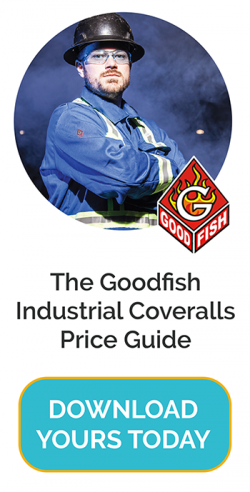Author: Goodfish Coveralls
Bump Up Your Cleaning Budget, Save on Coverall Purchases!
At Goodfish We Aren’t Just Cleaning Coveralls!
Oil & Gas Industry in Canada – Current State and Future Outlook
As far as the issue of energy security is concerned, Canada holds an enviable position among world nations. The domestic oil & gas industry is so huge, it is a vital component of the entire North American economy. Canada is only behind Saudi Arabia and Venezuela in the table of nations with the largest proven oil reserves. Besides oil, it is also one of the largest producers of natural gas in the world, with proven reserves that rank among the top 20 across the globe. Canada is rather unique among the nations with proven petroleum and natural gas reserves. Of its estimated 167.7 billion barrels of crude oil reserves, conventional oil accounts for just 4.3 billion barrels. The rest 163 billion barrels are found in the form of oil sands, which is classified as an unconventional source of oil along with shale oil and tight oil. Canadian oil sands account for nearly 64% of its total oil production (2017), with daily production exceeding 2.7 million barrels. The province of Alberta accounts for the vast majority of oil sand deposits, located in Athabasca, Peace River, and Cold Lake regions. Saskatchewan is another province with proven oil sand deposits. Canada also has enough natural gas to meet its domestic consumption for the next 300 years. To put things in perspective, 30% of the country’s energy needs are met by its natural gas production, which is also ranked the fourth highest in the world. Gas deposits are found all across Canada, in virtually every province from Nova Scotia to Newfoundland, Quebec, Alberta, Yukon, and British Columbia. With such massive mineral wealth, it is not surprising that the Canadian energy industries contribute quite a lot to the nation’s economy. Altogether, the energy industry in Canada contributed nearly 11% of the GDP in 2017, with oil and gas industries accounting for close to 60%. In a country with a GDP in excess of 1.6 trillion US dollars, that is quite an impressive figure indeed. According to Statistics Canada, extraction of oil and gas alone make up around 7% of the Canadian GDP, which is around the same as the banking and insurance services in the country. This is the highest it has ever been since 1998, indicating strong and sustained growth in the sector in the last two decades. As local production far exceeds demand, Canada is a huge exporter of oil and natural gas, with the vast majority of it headed south of the border into the US. The exports accounted for around 20% of total goods in 2017, worth $97 billion, with the US alone accounting for 91% of that. The industry contributes around $16 billion in the form of taxes to the Federal government as well as provincial and local counterparts, which is around 11% of the total government earnings. The energy sector in Canada employs and 276,000 people, accounting for 4.9% of the total national employment. Oil and natural gas extraction provide 0.4% of this, with 67,000 jobs generated directly. And when you factor in indirect employment through activities like construction, refining, transportation, and others, the total number of jobs generated exceeds 528,000 in 2017. An interesting fact of note here is the current trend in domestic production of crude oil and natural gas: experts studies indicate that production has already exceeded existing infrastructure capacities in Canada. The situation of pipelines is so serious that Canadian oil companies are being forced to sell crude at a significant discount to US buyers due to the increased cost of rail transportation. Capital investment in the domestic infrastructure has fallen in recent years, resulting in the present bottleneck. But the global oil industry showing signs of revival with prices bouncing back in recent years. Soon this trend should also reflect increased investment in oil and natural gas related industries in Canada in the near future. This would add even more jobs to the Canadian economy within the foreseeable future. The increase in jobs would also result in increased demand for essential equipment, like protective clothing. In an industry where fire hazards are a constant threat, flame retardant clothing is mandatory for a significant segment of the workforce. Local manufacturers like Goodfish have the expertise and experience to contribute to the growth of the Canadian oil and gas industry. As an enterprise wholly owned by the Whitefish First Nation in Alberta, Goodfish is also committed to responsible and sustained development, a vital requirement in an industry which has to work harder than most others to limit its ecological impact.

The Extent Of Oil & Gas Reserves in Canada
Oil & Gas Contributions to Canadian Economy

A Potent Employment Generator with Room for Growth

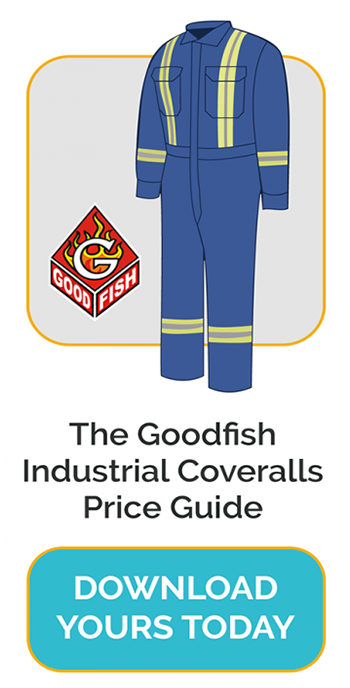
The Real Life Story Of One Man Saved (And 6 Other Reasons Why Safety Matters)
It is said that “safety doesn’t happen by accident.” Staying safe has to be a conscious decision, and efforts must be made to ensure that you are well-protected on the job, as well as the workplace.
No one knows this better than safety specialist Randy Burton who, in 2008, found himself living his worst nightmare. Without warning, Burton’s 505 truck suddenly caught fire and the leaping flames engulfed the vehicle’s cabin within moments – while he was inside. Fortunately for him, Burton survived the blaze, albeit with severe burn injuries. “The surgeon asked me what I was wearing that day: Goodfish coveralls. He told me that if I wasn’t wearing FR coveralls, I would have had about 98 percent of my body burned. No one survives that. He said I could thank my coveralls for saving my life,” says Burton.
The incident served to show the importance of flame-resistant (FR) clothing, such as what Burton was wearing that fateful day, in saving lives. It prompted him to take it upon himself to propagate the need for safety. “Since my accident, I have developed a deep passion for safety. Telling my story helps me to heal as well, as it helps the people listening to be more aware of the importance of keeping themselves safe,” adds Burton.
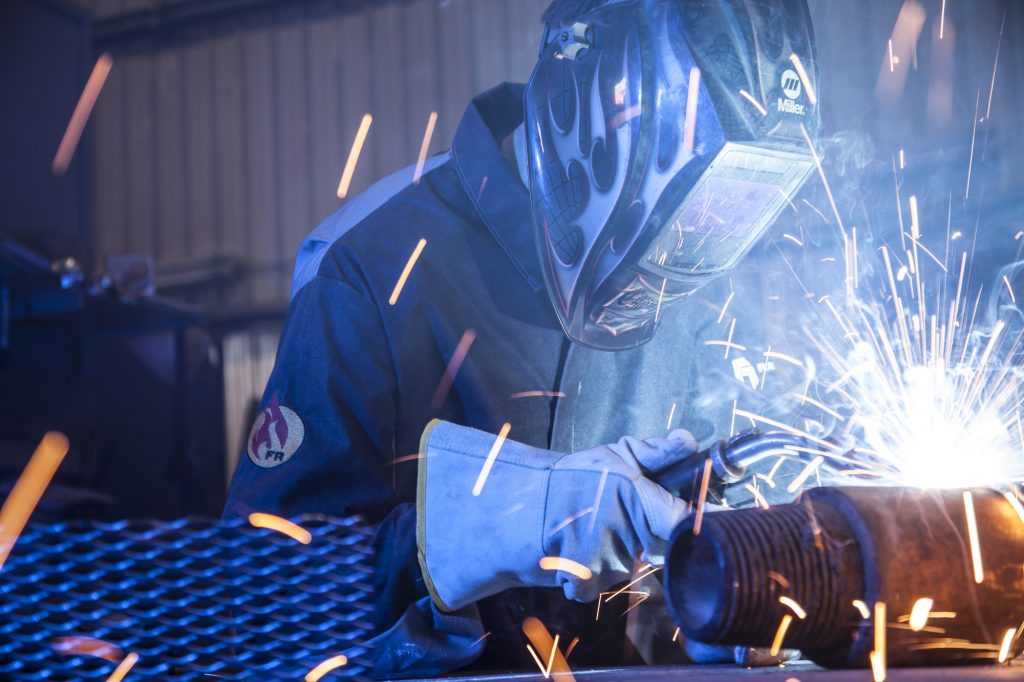
Source: Pixabay.com
What the Statistics Say
According to the statistics compiled by Canadian workers compensation boards, there were 904 work-related fatalities in 2016. In addition to these, 241,508 claims were received for lost time caused by a work-related disease or injury. It is likely that the number of workers who suffered injuries is higher, since these figures are only incidents that have been reported to the compensation boards, and subsequently accepted.
These numbers serve as a reminder that there are a good number of things that you can do to prioritize safety issues at the workplace. Besides avoiding deaths and injuries, there are some other reasons you need to look at safety measures:
- Corporate Financial Benefits
The aim of a business is to make money and putting in safety measures helps you do this. Accidents at the workplace can result in extremely high insurance and legal costs to your business. A safe workplace will have extremely low rates of injury and illness and this in turn, translates into higher profit margins.
- Enhanced Worker Productivity
Safe workers are happy workers and when people are happy, they tend to perform better. Lower rates of absenteeism and reduced attrition can boost productivity at the organization. Involving your employees in the program by seeking their opinion, and constituting committees for redressal of grievances related to safety issues at the workplace, you are showing them that you care.

Source: Pixabay.com
- Minimize Damage to Property
Even if there are no injuries to employees, certain accidents such as those involving electrical equipment or other machinery can result in property damages that can be expensive to repair or replace. Training employees well in the use and maintenance of such equipment and machinery can mitigate risks as well as reduce associated costs.
- Improves Service/Quality of Product
The link between quality of service or products and the safety record of the company is a strong one. When employees get to work in a safe environment that is free of distractions and hazards such as debris lying around or entangled wires, they tend to be more focused and thus, quality is assured.
- Protects Corporate Reputation
A company with a good safety record instills confidence in customers and investors alike. This conveys the message that being a company which worries about the health and well-being of its employees it is likely to feel the same way about others too. This enhances the brand value and the good will of the company in the market.
- Retains Customer Loyalty
The safety record of your workplace has an impact on your customers and is not restricted to your company and its employees. When there are a significant number of injuries, the pace of work is affected and you are likely to find it difficult to meet the requirements of your customers. If this happens, you cannot expect your customers to wait around for their orders to be completed and it is likely that they will switch loyalties.
Providing a safe working environment for every employee is the duty and moral responsibility of the employer. While the risks and dangers involved at the workplace will vary depending on the type of industry, it is important for organizations to adhere to the safety regulations and guidelines that pertain to their specific sector for all the reasons outlined here.
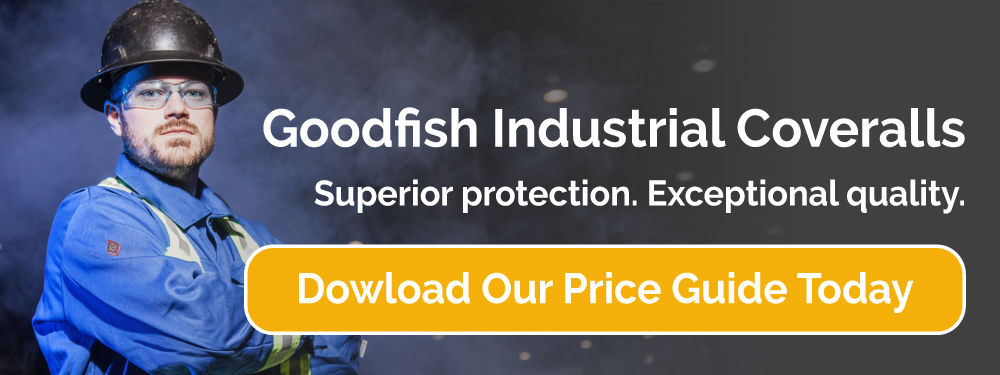
Top 5 Oil And Gas Related Projects in Alberta

Alberta is ranked Canada’s leading oil and natural gas producer and has vast oil sands deposits. Keeping this in mind, the government of Alberta has raised its financial incentives by $600 million for investment in petrochemical development related to oil and gas in the region. This will be offered in the form of future royalty credits and is in addition to the $500 million announced in March last year. Another $500 million had been separately earmarked at the time for loan guarantees. The government has received over twenty applications for such investments that are likely to be in excess of $60 billion.
The following are some significant oil and gas industry projects that are underway or have been recently completed and have benefited from these measures or are likely to do so in the near future.
1. Heartland Petrochemical Complex
Heartland Petrochemical Complex is a $3.5 billion dollar facility being developed by Inter Pipeline to use low-cost propane to churn out 525,000 tons of polymer grade propylene annually. Construction is underway and the complex is expected to be completed and operational by the end of 2021. The plant is slated to receive $200 million in royalty credits under Alberta’s Petrochemical Diversification Program. The total number of direct and indirect jobs created in the region during the construction process is expected to be at least 13,000 over four years.
2. Pembina Gas Plant Expansion
Early in 2018, Pembina Pipeline Corporation stated that it would set aside around $120 million for the construction of new facilities for terminalling and fractionation. Expected to be operational by 2020, the facility will be at Pembina’s existing Empress extraction plant near Medicine Hat. Pembina’s fourth quarter 2017 investor report claims that this will help boost the company’s NGL volumes while ensuring greater propane supply access.
3. Orion Thermal Project Expansion
In October 2018, Osum Oil Sands Corp. completed its expansion project at the Orion Thermal Project which is situated near Cold Lake. The Phase 2B and 2C expansions which were completed ahead of schedule have led to a 30 percent increase in steam capacity at the SAGD facility. The company expects to see the capacity nearly double by the end of third quarter of 2019 and is also likely to proceed with its 2D expansion plans. The Orion property was purchased by Osum from Shell in 2014 at a price of $325 million.
4. Trans Mountain Pipeline Expansion
This project that aims to extend the Trans Mountain service from Strathcona County, Alberta, to Burnaby, British Columbia, had to suffer starting delays due to challenges in procuring necessary permits. Spearheaded by Kinder Morgan, this $7.4 billion project is now likely to be completed in September 2020 but it can be 2022 before the new pipeline is fully operational. This project involves twinning of the original 1,150 km pipeline that was built in 1953 to enhance the nominal capacity of the system to 890,000 barrels per day from the existing 300,000 barrels.
5. MEG Energy Oilsands Expansion
In May 2018, MEG Energy announced that it had commenced expansion of its Christina Lake in situ oilsands project. Known as the Phase 2B Brownfield Expansion, the $275 million project is expected to be completed in 2020. The company has already capacity contracted the increased oil production volumes on the Seaway Pipeline and Flanagan South pipeline headed for the U.S.

Source: pixabay.com
With such major projects making inroads into the Alberta oil and gas industry sector, the region seems poised for an economic upswing. While all these projects have been undertaken by various companies with different budgets, the one thing common to all is the employment opportunities each of these have generated. A larger workforce means greater responsibility on the employer to ensure the safety and well-being of employees given the nature of the industry.
Protective clothing such as flame-resistant (FR) coveralls is a must for every worker in the sector. It is essential to ensure that such apparel is manufactured in keeping with the regulatory requirements as prescribed by agencies such as the Canadian General Standards Board (CGSB) and the Canadian Association of Petroleum Producers (CAPP). Durability and comfort must be kept in mind when choosing this type of work wear as also the fit and type of material used. Coveralls intended for industrial usage that are flame-resistant while offering arc flash protection such as those manufactured by Goodfish are likely to be your best bet.
Ensuring proper maintenance of FR apparel can help retain the effectiveness of the garment. Being aware of the risks in the industry and taking all necessary precautions is the best way of turning opportunities into successful ventures.
PARTICIPATING IN UPCOMING SHUTOWNS OR TURNAROUNDS?
Goodfish Lake has you covered. Not only do we offer the best Turnaround coveralls in the industry but we have Largest Industrial Drycleaning facility in Canada
- The only company that Manufactures Coveralls while featuring Industrial Drycleaning, Industrial Laundry and Repair Services.
- In addition we are 100% Aboriginally owned and Operated with over 90% aboriginal employment.
- Give yourself a leg up on your competition for future bids by contacting Goodfish Lake today Continue reading “Top 5 Oil And Gas Related Projects in Alberta”
Goodfish and The Community: Why We’ve Been In Business For Decades
Starting a business is the easy part; staying in business for years, decades even, is what is challenging. With over four decades under our belt and still going strong, we believe strongly that it is all the effort that we put in daily, and the commitment to our mission that has helped us get here. Despite the expansions that we have seen over the years, we have not strayed from the aim of our mission that is to build a solid economic foundation for the aboriginal people of Goodfish Lake. Following the basics of business—not overlooking the small things, understanding and meeting the needs of clients, sticking to core values, appointing the right people for the job and treating them the right way—is the secret to our success. Another important element that has contributed to Goodfish staying strong in business has been the great relationship that we have with the community we live in. We at Goodfish Lake Business Corporation (GFLBC), believe that investing in the community we are a part of, and giving back to those who have been with us through the good and the bad, is essential to nurturing connection. That’s why half of all our profits are invested into three trusts for the Nation, and our local employment for the community totals over $4 million dollars in wages. We expect this figure to increase from year to year as we continue staying strong in business. Vivian Jackson who has been with GFLBC for over three decades says, “First of all, this job brings stability to the people in the community and if need be, there’s a daycare just around the corner. Secondly, it helped me provide for my family for 34 years and thirdly, it provides a job for the community members.” Our employees recognize the value that we add to their lives as well as the job experience that enables them to climb the ladder of success gradually. Take for example, Calvin Steinhauer, Director of Operations, Laundry and Dry Cleaning Division. Having started off as a general manager of dry cleaning a year and a half ago, he reiterates the value-addition aspect of being a GFLBC employee. “The effect the organization has is quite large since we employ about 150 people full-time in the community. It helps put food on their tables, keeps them close to home, and also helps them transition from working with us and then be able to work off the reserve as well. It’s a good opportunity, a place to get a head start to be able to leave the community and work off the reserve,” says Steinhauer. Our employees take pride in their work and are happy to stay close to home. As far as employment prospects for the community are concerned, Ron Jackson, a longtime employee of GFLBC sums it up aptly. “I have been employed for 25 years with this company and the company has benefited the community in a lot of ways; employment-wise and even the whole area is impacted. It’s employed generations, it’s been in business for decades. We pride ourselves on our quality of work here and that’s why I think we are still going,” he says. The period from 2015-2018 saw us with 264 employees with not a single person laid off despite the downturn. Brandon Whitford, Customer Service Assistant for Transportation and Logistics, says, “this company has benefited me in a big way because I started as a regular laborer and worked my way up through supervisor transportation. My job is close to home and it is a great environment.” We do everything possible to ensure the continued education and training of our employees, and try to provide them with a support system that enables them to give their best every day. This year, 30 of our employees will be taking part in the 12 module Dale Carnegie training program on effective communication and HR. Another employee will be pursuing a certificate program at the University of Alberta. Along with all these reasons that have helped us stay strong in business for decades, we have also managed to remain an enterprise that is wholly owned and operated by the aboriginal community. Lastly but not least of all, we believe that seeking employee and community feedback and (acting upon this information accordingly) is the best way to improve ourselves in order to keep moving ahead for decades to come.
Giving Back
Adding Value
Providing Employment
Employee Retention
Education and Training

High-Visibility Clothing Standards and Regulations: Everything You Need To Know In 2018/2019
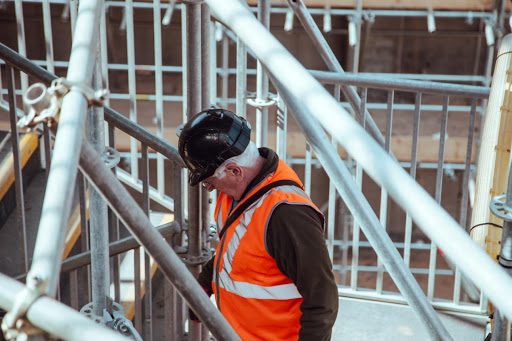
High-Visibility Clothing Standards and Regulations: Everything You Need To Know In 2018/2019
High-visibility clothing, also known as high-visibility safety apparel (HVSA), is worn by workers in various sectors to ensure that people are aware of their presence at a particular spot. It is usually worn when there are low light or poor visibility conditions at the workplace and at hazardous work sites such as mines, oil rigs, gas plants, construction sites, and the like. The global HVSA market was valued at US$ 1415.1 million in 2017 and is expected to grow at a CAGR of 6.1% till 2025.
Purpose of High-Visibility Clothing
Injuries and fatalities have occurred at a good number of workplaces due to objects or equipment coming in contact with the workers particularly under poor visibility conditions. This is where high-visibility apparel can help by making it easy for workers to be spotted by others especially motorists on the road and equipment operators during day as well as night. This protects their health and safety while they go about their jobs.
Bright, fluorescent colors are easily spotted by the human eye. When there is a significant contrast between the clothing and the environment that the worker is located in, it is easier to see the individual. Wearing high-visibility headwear in addition to such apparel can further enhance the safety aspect.

High-Visibility Clothing Regulations and Standards
The Canadian Standards Association (CSA) provides two different standards for high visibility clothing. While the CSA Standard Z96-09 relates to design and manufacture of such clothing, CSA Standard Z96.15 sets guidelines for selection, use, and care of such apparel. Both these standards are considered industry best practice for workers engaged in employment on surface during daylight hours.
For those working underground or from sunset to sunrise, Regulation 854 is applicable. This regulation is similar to the CSA standard but is a little more restrictive. Reputed manufacturers and dry cleaners of protective clothing such as Goodfish diligently adhere to these high-visibility clothing regulations and standards to ensure the safety of all who use the apparel.
Classification of High-Visibility Clothing
There are three classes of high-visibility apparel based on their retro-reflective properties, the colour and luminosity of the background material, and the kind of coverage to be provided by the high-visibility components.
- Class 1 gives good visibility with the lowest required coverage
- Class 2 offers superior visibility with moderate coverage
- Class 3 affords maximum coverage and visibility in low light conditions
CSA Z96-15 High-Visibility Safety Apparel Standard specifies the type of color of the background as well as that of the stripes or bands required for all classes. Fluorescent yellow-green, fluorescent red or fluorescent orange-red, bright orange-red, or bright yellow-green, are recommended for background materials. Stripes and bands on the apparel should also meet these CSA criteria:
- A horizontal band or stripe at the waist level that goes around the apparel
- A symmetrical ‘X’ on the back from shoulders to the waist
- A pair of vertical stripes on the front extending down shoulders to waist
- Bands or stripes encircling both legs and arms are essential when it comes to Class 3 clothing
Who Needs to Use High Visibility Clothing?
According to the CSA Standard, it is essential to perform a hazard assessment at the job site to get an estimation of all known or possible dangers to workers while engaged in their duties. The type of work being done, possibility of being exposed to flames or heat, whether it is indoors or outdoors, temperature, presence of traffic or vehicles are all factors that will figure in this assessment. Following the assessment the employer is required to put in place various appropriate controls. High-visibility clothing is considered the last line of defense against accidents. Emergency responders, workers who have to be underground and surface workers who have to work in low light conditions or at night, should be issued such clothing. Workers involved in industries that involve electrical hazards or gas and oil applications are likely to need garments with flame-resistant properties besides high visibility.
George Swartz, retired director of safety and occupational health, Midas International, Itasca, Illinois, says that employers need to put some thought into determining the appropriate protective clothing for workers. “They’ve got to think a little deeper into the process so they know whether they need this reflective clothing,” he said.
When you purchase high-visibility clothing, it is suggested that you seek proof that indicates the materials used as well as the design are in accordance with the CSA-Z96-15 Standard. Also, it is essential that workers be trained in the proper care and use of this specialized apparel.

The Ultimate Guide to Expert FR Coverall Maintenance
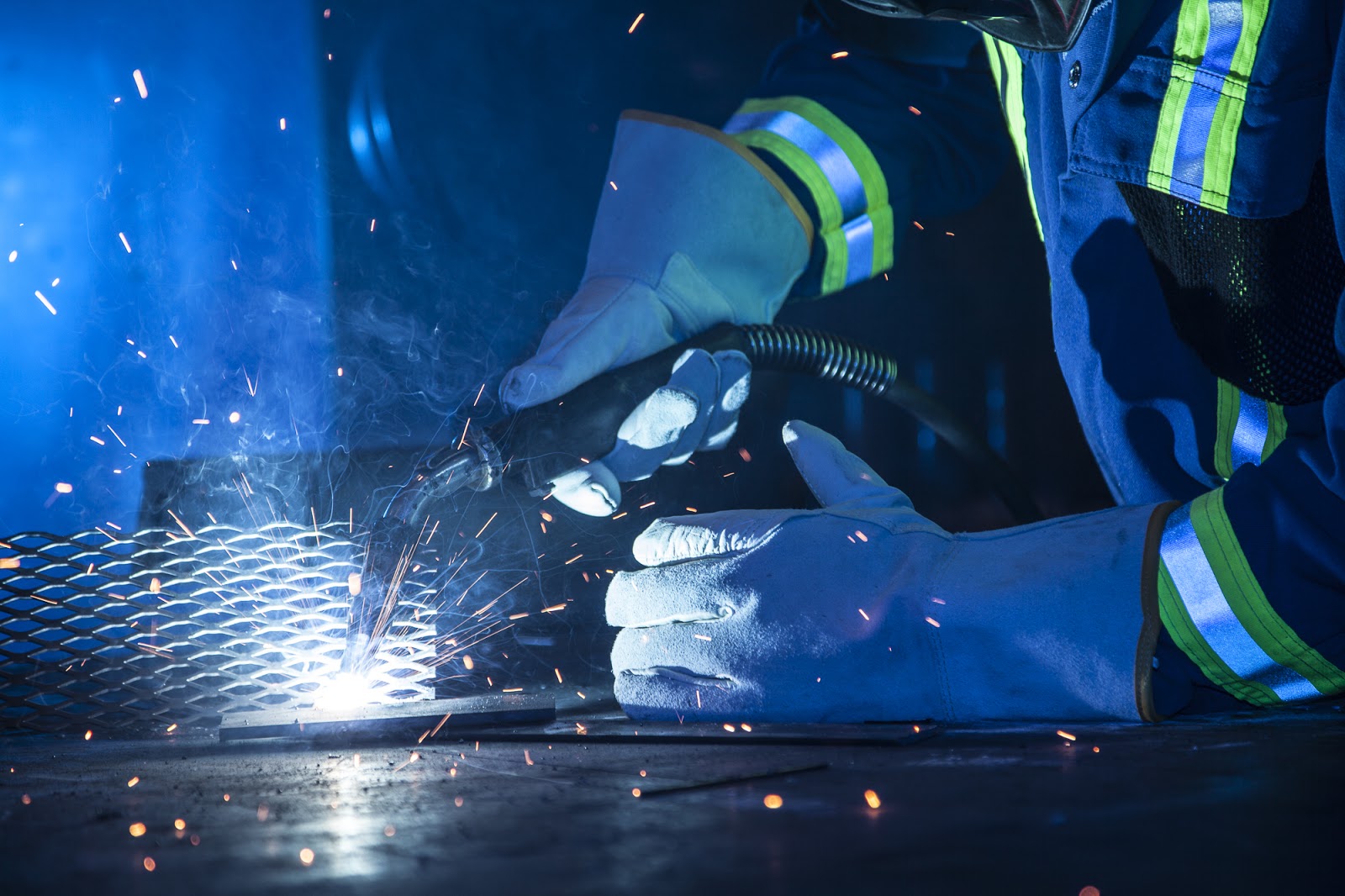
The Ultimate Guide to Expert FR Coverall Maintenance
With the implementation of the new regulatory system in the Alberta oil and gas industry, fresh projects are likely to be put on the fast track to approval. Seen as a significant step in the modernization of industry practices, this move is expected to result in direct savings amounting to $600 million annually by 2021.
This is also likely to translate into more business opportunities and jobs in the region underscoring the need to put your company at the forefront of this changing scenario. As a result, providing a safe work environment for employees also assumes greater significance. While it is true that flame-resistant (FR) clothing is an integral component of your organization’s safety program, simply ensuring that your employees wear protective gear does not absolve you of further responsibilities. FR clothing such as coveralls are most effective as a preventive measure when properly selected, used the right way, and maintained well.

The Right Care for FR Coveralls
When the quality of FR clothing deteriorates due to improper maintenance or as a result of being worn out, it can compromise the safety of the wearers and put them at risk of fire hazards. The right type of maintenance can also significantly extend the life of your FR clothing, thus sparing you the cost of purchasing new coveralls frequently. As Benjamin Franklin aptly phrased it, “Beware of little expenses; a small leak will sink a great ship.”
Encouraging your employees to hang up these coveralls when not in use is just as essential as having them laundered the right way. Make it a point to remember the following in your attempts to ensure optimal efficiency of FR clothing.
Clean Regularly
It is advisable to clean FR apparel before using it for the first time. Every wash must be in accordance with manufacturer’s instructions. Frequent cleaning can help prevent the accumulation of hydrocarbons.
Watch For Foul Smells
Just because an FR coverall looks stained, it does not mean that it is unsafe. However, if the coveralls smell of fuel – stained or not, it indicates the presence of a possibly combustible substance. In this instance, it is essential to wash the garment till the odor is washed off. The earlier the soiled garment is washed, the better it is.
Avoid Certain Products
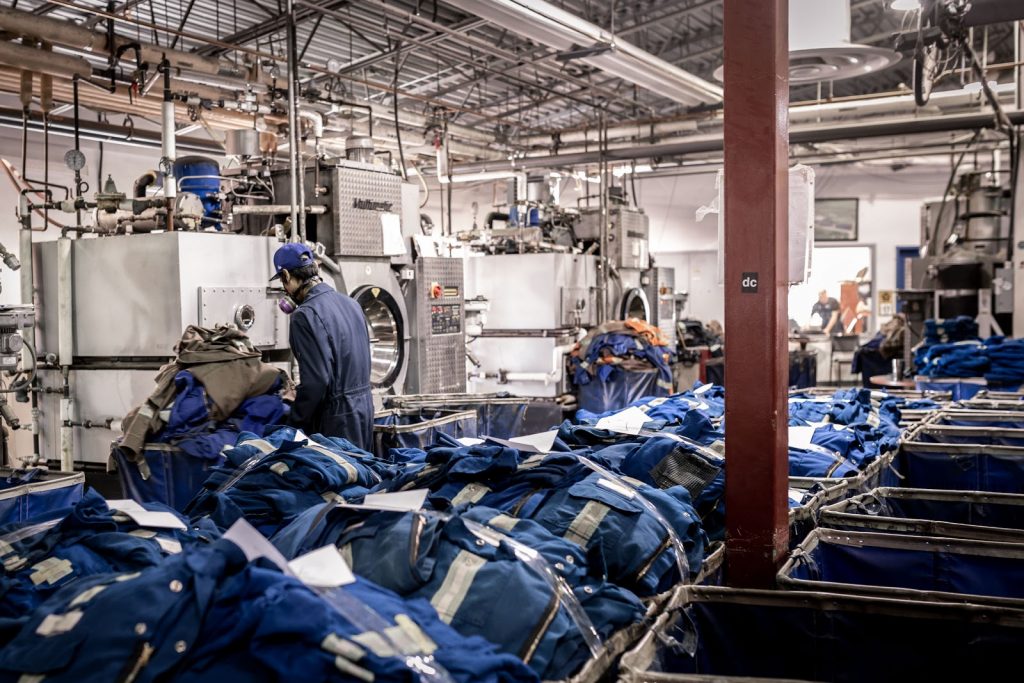
Never make use of peroxide or bleach to wash an FR coverall. These can cause harm to the fabric even if used as an additive to detergent. Fabric softeners, insect repellents with a DEET-base, and starch are all best avoided as they can lead to buildup on the surface of garment fibers.
Seek Professional Help
Getting your FR coveralls cleaned professionally is a good way of ensuring that the efficiency of the fabric is not compromised in any way. Organizations such as Goodfish that offer specialized dry cleaning for work wear in the oil and gas industry use the latest technology to facilitate their large scale commercial laundry programs. These methods successfully eliminate hydrocarbons present on protective clothing without reducing its flame-resistance in any way.
Engage in Regular Inspection
It is essential to check every FR coverall regularly for any signs of wear and tear. At the first such indication, it is advisable to repair it or replace it. Some manufacturers might also indicate the service life of your industrial FR workwear. If your coveralls are past this suggested date, then it might be best to discard them and invest in new ones. Most clothing manufacturers suggest replacing coveralls that are threadbare, frayed, or ripped.
Repairs are a Must
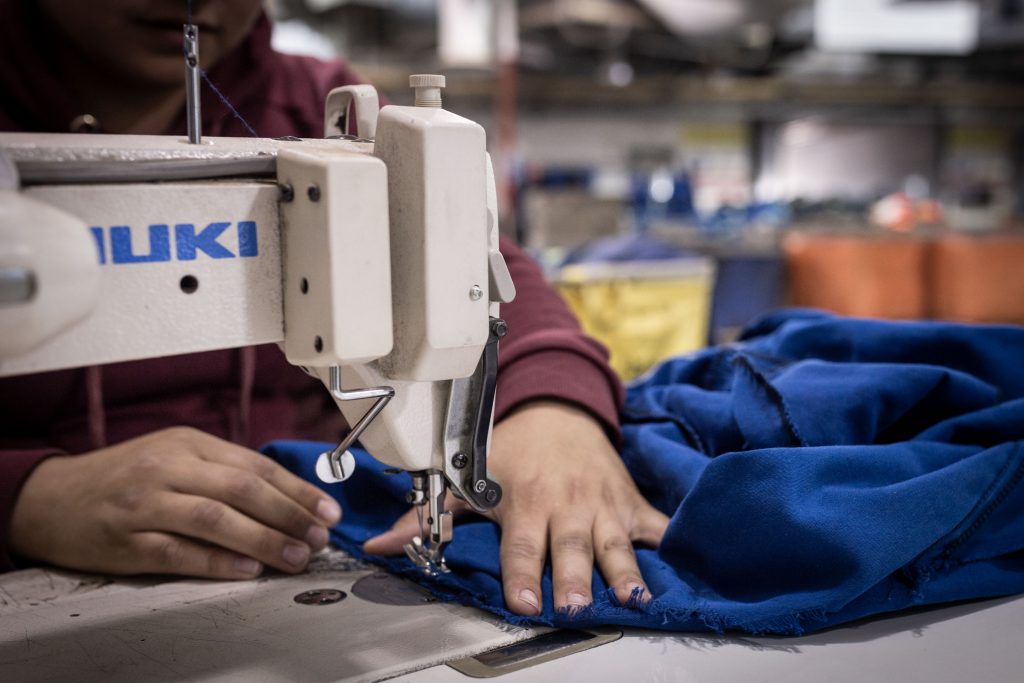
The slightest of cuts, tears, and holes can cause a decline in the FR properties of the fabric. If repairs are possible, such as a rip not greater than three inches or a hole smaller than a quarter, these should be in accordance with manufacturer guidelines. FR thread as well as various FR components such as zippers, buttons or patches from the same type of material as the coveralls, must be used in the repair process. Ideally, you should get the repairs done at an authorized facility or send it to the manufacturer for the purpose.
Besides adherence to industry standards and adoption of best practices as regards fire safety at the workplace, it is important to provide your employees training in proper use of the clothing. By making sure that the protective clothing worn by your employers is not damaged in any way, you can help prevent tragedies such as burn injuries from occurring at the workplace.


7 Points to Consider when Purchasing FR Coveralls

7 Points to Consider when Purchasing FR Coveralls
A recent study by Toronto-based eCompliance, a software company, indicates that the greater the involvement of workers in safety at their workplace, the better the safety performance. Safety concerns are a priority at most workplaces with dangerous conditions such as the oil, petroleum, natural gas, coal, and minerals industries, utilities, and food processing plants. There is a need for different types of protective gear including clothing with flame-resistant (FR) properties to safeguard them from the dangers of flash fires, arc flashes and more.
So, here are some factors to consider before you dive in and purchase FR coveralls to ensure you’re making the right choice:
Regulatory Requirements
Various non-profit organizations, as well as government bodies, issue guidelines for protective clothing to be worn by workers in hazardous occupations. The Canadian General Standards Board (CGSB), and the Canadian Association of Petroleum Producers (CAPP), are two such regulators who specify standards for FR clothing intended for the petroleum, oil, and natural gas industry. It is important to keep these specifications in mind when you buy FR coveralls.
What are your Hazards ? Flash Fire, Arc Flash, Hot Liquids
It is of out most importance that you take the time to understand the hazards your employees face on a day to day basis. Though quite similar, FR Fabrics have different properties that offer different levels of durability and protection. Make sure your coverall supplier offers solutions for your work environment. Coveralls options for industrial usage, such as the ones produced by Goodfish, are not only flame-resistant, they also offer protection from arc flash. If you are in a hot fluid situation we would love to hear from you as well to discuss your option
Material Used
Some types of materials are naturally resistant to flames and do not have to be subjected to chemical treatment. Silk and wool are two classic examples of such fibers. The tighter the weave of the wool, the greater are its FR properties.
While nylon and polyester are difficult to ignite, they do melt upon catching fire. Meanwhile, linen and cotton tend to catch fire easily, but can be chemically treated to extinguish flames. Modacrylic, Kevlar, and Nomex are some fibers that possess flame-resistance thus, making them a suitable choice for such apparel.
Alt-text: Some essential factors need to be considered before you buy FR coveralls such as those worn by the workers here.
Durability
Nothing lasts forever, and neither will FR coveralls. However, these are not items that you want to or can afford to keep purchasing on a frequent basis. So, look for clothing that is durable and can withstand the rigors of the oil and gas sector. The average lifetime of FR clothing can be anywhere from nine months to five years depending on the frequency of use, the material, and the cleaning process it goes through.
Comfort
It is important that your workers stay comfortable while wearing protective clothing. While there was a time when choices were limited when it came to FR clothing, this is not the case today. The high quality materials used by reputed brands in the FR clothing segment ensure comfort with safety. This makes it necessary to look at a good brand along with the appropriate size and material when it is time to buy FR coveralls.
The Fit
With FR clothing, a looser fit is thought to offer better protection because it provides an extra layer of air between the wearer and the garment. This insures added insulation against flames or heat in the event of a fire accident. Tight clothes can bring the fire into immediate contact with skin. It is essential to look for coveralls that are not too loose either because these can snag on equipment or other objects in the work zone which can prove dangerous.
Maintenance Required
The right type of care and maintenance is essential not only to ensure the longevity of FR clothing. Not doing this can strip the clothing of its FR properties and thus, make them less effective in hazardous environments. Special laundering is required to ensure that this does not happen and you get the best use out of FR clothing. So maintenance costs will have to be factored in while making your choice.
Using the right type of FR coveralls best suited for your area of operations is critical to the safety and well-being of your employees. Knowing the kind of risks involved in your industry and being aware of the necessary safety regulations can help you in this. Being armed with knowledge about the types of fabrics used in FR coveralls, the kind of maintenance necessary, and following safety standards ensures that you are doing your best to safeguard your employees.
Goodfish is armed with everything you need to maintain and guarantee that your FR coveralls will last and thrive in your work environment. Find out more today.

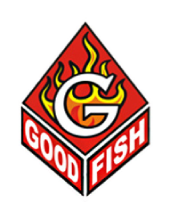





 Your privacy is important to us, and we are committed to protecting your personal information.
Your privacy is important to us, and we are committed to protecting your personal information.